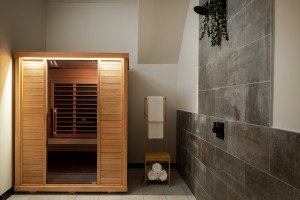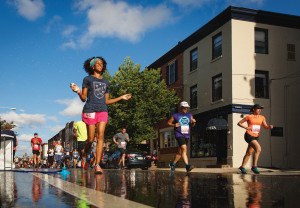How Strength Training Helped One Trans Fitness Instructor Come to Terms With Their Body
Asher Freeman, founder of the Nonnormative Body Club, shares their Transformation story.

Asher Freeman, a transgender fitness instructor and the founder of the Nonnormative Body Club, shared their transformation with us. / Photograph by Michelle Gustafson
When I was 25 years old, I lost my dream job. The small queer and trans youth center where I worked was moved under the umbrella of a larger organization — one that was in direct conflict with my values. When I spoke up and my position was threatened, I had to choose between keeping my mouth shut in exchange for a paycheck and walking away from a place that had become intimately enmeshed with my identity.
I had been out as trans for about a year when I left my job. But long work hours and the community organizing that filled my limited free time meant I never had space to engage with my gender dysphoria, which caused a disconnect between my mind and body. At least once a day, I was so debilitated and overwhelmed by sharp pains in my stomach that all I could do was lie on my back, waiting for it to dissipate. It would be years until I recognized that this was a problem, and only then did I make the connection between my stomachaches and the bottomless cups of coffee that I drank to keep up with my unmanageable schedule. It was much easier to focus on external work than to reckon with this weird, discordant sack of flesh that happened to be along for the ride. Yet unemployment meant I no longer had a job title or overtime hours to hide behind. It was time to face my dysphoria, which had grown from a distant buzzing to an all-consuming alarm.
In an effort to salvage my deflated ego, I decided to create an unemployment bucket list. I needed projects and goals that were completely within my control. The first item on my list: sign up for a free gym trial — and actually use it.
It’s not that I hadn’t been physically active. I grew up playing soccer, and I’ve commuted by bike since I was 19. However, all the exercise I loved centered around gross motor skills. I could bike, run, kick, and throw without ever paying attention to specific muscle groups. My mind was most at ease whenever I was pushing my body to its limits, or more accurately, ignoring its limits. When my heart was pounding hard enough, it could almost drown out the constant buzz of discomfort.
I began a new hobby of cashing in on every free gym trial in the city. Each time I received a one-on-one training session at a new gym, I soaked in as much information as I could about strength training equipment and exercises and tried to incorporate all of it into my daily workouts.
But I still had absolutely no sense of which muscles were doing work. I remember sitting on a hip adductor machine, squeezing my thighs together against the resistance of the pads when I felt the muscles of my pelvic floor engage for the first time. Immediately, nausea set in. I had survived in my body until that point by completely detaching from the parts that gave me the most discomfort. Engaging my pelvic floor meant letting go of a coping mechanism that had enabled me to move through the world without a debilitating level of dysphoria.
When I got home that day, I felt nervous that I’d hit a wall and would not be able to return.. But I went back to the gym the next day, partially because I wanted to work toward attainable, straightforward goals like lifting heavier weights — and partially because I was beginning to taste what it might feel like to have a more integrated relationship with my body.
For one hour every day, I went to the gym and explored what it meant to be in my body. While it would be a few years before I began hormones and underwent top surgery, I mark the beginning of my physical transition with the start of my strength training. It required awareness of how every part of the body moves through space, a presence of mind to stabilize some muscle groups while moving others.
I can’t put my finger on the moment when I first recognized the difference between engaging my quadriceps and my hamstrings. Gradually, over the years of trying out gyms — and eventually committing to a couple — my muscular control and awareness of my body improved. I learned how to stand with my shoulders back, chest out, and gaze directly in front of me — a posture that both provides a stable base in weightlifting and enables me to face the world from a more rooted place. I experienced the freedom of being present enough in mind and body that my external work could be an authentic articulation of my values rather than a frantic attempt at escape.
When I eventually made the decision to leave behind a decade of jobs in youth work and community organizing to pursue a career in personal training, many of my colleagues were confused. However, I feel that my job now is essentially the same work I’ve done for years with a few new tools. For me, fitness education is about strengthening communities by empowering individuals. It is easy for so many of us to become detached from our bodies and our pain when capitalism teaches us that our value is determined solely by external factors like job titles and wages. Finding home within our physical forms can be a revolutionary act.
On some days, I still struggle to find peace with my own body. There are still body parts that make me squirm with discomfort. This process of healing, both as a trans person and as a human living under capitalism, is nonlinear. It requires a willingness to continually combat harmful ideals that are deeply ingrained. But through it all, I am grateful to be building community through this work and writing new narratives together about our individual and collective power.


